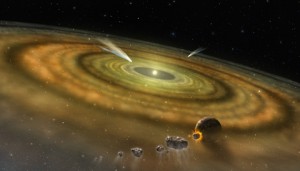The comets in the infant planetary system around Beta Pictoris come from two families.
Eight years of measurements from the HARPS spectrograph in Chile have revealed two distinct populations of comets in the forming planetary system around Beta Pictoris, Flavien Kiefer (Paris Institute of Astrophysics) and colleagues report in the October 23rd Nature.

Credit: NASA / FUSE / Lynette Cook
Astronomers already knew cometary bodies fill the disk around Beta Pic: work by members of the same team in the 1980s and 1990s found hints of evaporating bodies traversing in front of the star. These bodies block certain wavelengths of starlight when they pass between us and Beta Pic, leaving absorption features in the light that come and go over the course of several hours.
The new results are an analysis of 1,106 spectra taken from 2003 to 2011, containing variable calcium absorption features from an estimated 493 exocomets. (To avoid double-counting, the team only looked at one spectrum per day.) To make the signals clearer, the team averaged spectra over 30 minutes to boost the detections. Still, there are so many evaporating bodies in this infant planetary system that, in each 30-minute spectrum, there’s an average of six comets passing in front of the star.
What’s interesting about the new report is that these stargrazing exocomets fall into two distinct groups. Of the 252 bodies for which the team could calculate physical info, roughly half fall into each population. Population D (for “deep” absorption lines) all approach Beta Pic from the same direction and spew out more gas (the astronomers can tell because the coma tends to block more of the star’s disk). Population S (for “shallow” absorption lines) come from all directions and evaporate less — which is odd, because their wider absorption lines indicate that they come twice as close to the star as D exocomets do.
Why D bodies put out more gas is unclear. The team suggests that a larger body fragmented out in the disk, producing a population of newly minted comets with fresh, evaporatable material on their surfaces that all follow the same orbit — like the Kreutz family of sungrazers in the solar system. Or perhaps the D exocomets are just bigger.
On the other hand, the S bodies behave like “old exhausted” comets, the team says. Their orbits suggest that they might be controlled by a massive planet (perhaps Beta Pictoris b) that keeps sending them in around the star as they’re pushed into highly elongated orbits.
The team also found four comet-like features in spectra of the star HD 172555, which it reported in the January 2014 Astronomy & Astrophysics Letters. Both systems are in the same group of stars and a few tens of millions of years old. Perhaps long-term spectroscopic studies of other edge-on planetary systems might reveal comet transits, too.
Fun fact: The planet Beta Pictoris b was officially discovered in 2008, but members of this same team potentially saw its effects decades earlier. In 1995 the team reported light variations in observations taken from 1975 to 1992 that could be explained by a planet at least 6 Earth-Sun distances from Beta Pic and somewhere between 1.1 and 1.6 times Jupiter’s radius; Beta Pic b orbits at 9 Earth-Sun distances and is 1.7 Jupiter radii.
References:
F. Kiefer et al. “Two Families of Exocomets in the Beta Pictoris System.” Nature. October 23, 2014.
F. Kiefer et al. “Exocomets in the Circumstellar Gas Disk of HD 172555.” Astronomy & Astrophysics Letters. January 2014.
H. Beust et al. “The Beta Pictoris Circumstellar Disk.” Astronomy & Astrophysics. September 1990.
A. Lecavelier des Etanges et al. “Beta Pictoris: Evidence of Light Variations.” Astronomy & Astrophysics. July 1995.
The delightful autobiography of comet hunter Leslie Peltier, Starlight Nights, is available in print and as an eBook.
 0
0









Comments
You must be logged in to post a comment.